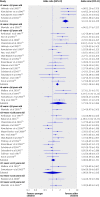Factors associated with the presence of diabetic ketoacidosis at diagnosis of diabetes in children and young adults: a systematic review
- PMID: 21737470
- PMCID: PMC3131115
- DOI: 10.1136/bmj.d4092
Factors associated with the presence of diabetic ketoacidosis at diagnosis of diabetes in children and young adults: a systematic review
Abstract
Objective: To identify the factors associated with diabetic ketoacidosis at diagnosis of type 1 diabetes in children and young adults.
Design: Systematic review.
Data sources: PubMed, EMBASE, Web of Science, Scopus, and Cinahl and article reference lists.
Study selection: Cohort studies including unselected groups of children and young adults presenting with new onset type 1 diabetes that distinguished between those who presented in diabetic ketoacidosis and those who did not and included a measurement of either pH or bicarbonate in the definition of diabetic ketoacidosis. There were no restrictions on language of publication.
Results: 46 studies involving more than 24,000 children in 31 countries were included. Together they compared 23 different factors. Factors associated with increased risk were younger age (for <2 years old v older, odds ratio 3.41 (95% confidence interval 2.54 to 4.59), for <5 years v older, odds ratio 1.59 (1.38 to 1.84)), diagnostic error (odds ratio 3.35 (2.35 to 4.79)), ethnic minority, lack of health insurance in the US (odds ratio 3.20 (2.03 to 5.04)), lower body mass index, preceding infection (odds ratio 3.14 (0.94 to 10.47)), and delayed treatment (odds ratio 1.74 (1.10 to 2.77)). Protective factors were having a first degree relative with type 1 diabetes at the time of diagnosis (odds ratio 0.33 (0.08 to 1.26)), higher parental education (odds ratios 0.4 (0.20 to 0.79) and 0.64 (0.43 to 0.94) in two studies), and higher background incidence of type 1 diabetes (correlation coefficient -0.715). The mean duration of symptoms was similar between children presenting with or without diabetic ketoacidosis (16.5 days (standard error 6.2) and 17.1 days (6.0) respectively), and up to 38.8% (285/735) of children who presented with diabetic ketoacidosis had been seen at least once by a doctor before diagnosis.
Conclusions: Multiple factors affect the risk of developing diabetic ketoacidosis at the onset of type 1 diabetes in children and young adults, and there is potential time, scope, and opportunity to intervene between symptom onset and development of diabetic ketoacidosis for both parents and clinicians.
Conflict of interest statement
Competing interests: All authors have completed the Unified Competing Interest form at
Figures





Comment in
-
Diabetic ketoacidosis at the onset of type 1 diabetes.BMJ. 2011 Jul 7;343:d3278. doi: 10.1136/bmj.d3278. BMJ. 2011. PMID: 21737468 No abstract available.
References
-
- DIAMOND Project Group. Incidence and trends of childhood type 1 diabetes worldwide 1990-1999. Diabet Med 2006;23:857-66. - PubMed
-
- EURODIAB ACE Study Group. Variation and trends in incidence of childhood diabetes in Europe. EURODIAB ACE Study Group. Lancet 2000;355:873-6. - PubMed
-
- Ali K, Harnden A, Edge J. Type 1 diabetes in children. BMJ 2011;342:d294. - PubMed
-
- Wolfsdorf J, Craig M, Daneman D, Dunger D, Edge J, Lee W, et al. ISPAD clinical practice consensus guidelines 2009. Chapter 10: diabetic ketoacidosis. Pediatr Diabetes 2009;10(suppl 12):118-33. - PubMed
Publication types
MeSH terms
LinkOut - more resources
Full Text Sources
Medical
